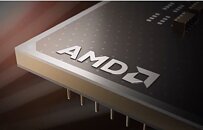Friday, September 18th 2020

AMD "Vermeer" Zen 3 Processors Branded Under Ryzen 5000 Series?
AMD is allegedly preparing to market its next-generation Socket AM4 desktop processors based on the "Vermeer" MCM, under the Ryzen 5000 Series. The "Vermeer" MCM implements the company's "Zen 3" microarchitecture in the client segment. It features up to two 7 nm-class CPU complex dies with up to 8 cores, each, and a refreshed cIOD (client IO die). AMD has allegedly improved the cIOD with a new memory controller and several new toggles that improve memory bandwidth. The cIOD combines a PCI-Express Gen 4 root complex with a dual-channel DDR4 memory controller. With "Zen 3," AMD is also introducing an improved boosting algorithm, and an improved SMT feature.
Coming back to AMD's rumored nomenclature, and we could see the company bumping up its processor model numbers to the 5000 series for equivalent core-counts. For example, the Ryzen 9 5900X is a 12-core/24-thread part, much like the 3900X; whereas the Ryzen 7 5800X is an 8-core/16-thread part. This flies in the face of rumors that AMD could take advantage of the 8-core CCX design of the "Zen 3" microarchitecture by carving out 10-core parts using two CCDs with 5 cores enabled, each. The reason AMD is skipping the 4000 series numbering with "Vermeer" probably has something to do with "Renoir" taking up many of the 4000-series model numbers. "Renoir" is based on "Zen 2," and recently made its desktop debut, albeit as an OEM-exclusive. The company is planning to introduce certain 4000G series models to the DIY retail segment. AMD is expected to announce its first "Zen 3" client-segment processors on October 8, 2020.
Sources:
VideoCardz, Patrick Schur (Twitter)
Coming back to AMD's rumored nomenclature, and we could see the company bumping up its processor model numbers to the 5000 series for equivalent core-counts. For example, the Ryzen 9 5900X is a 12-core/24-thread part, much like the 3900X; whereas the Ryzen 7 5800X is an 8-core/16-thread part. This flies in the face of rumors that AMD could take advantage of the 8-core CCX design of the "Zen 3" microarchitecture by carving out 10-core parts using two CCDs with 5 cores enabled, each. The reason AMD is skipping the 4000 series numbering with "Vermeer" probably has something to do with "Renoir" taking up many of the 4000-series model numbers. "Renoir" is based on "Zen 2," and recently made its desktop debut, albeit as an OEM-exclusive. The company is planning to introduce certain 4000G series models to the DIY retail segment. AMD is expected to announce its first "Zen 3" client-segment processors on October 8, 2020.

38 Comments on AMD "Vermeer" Zen 3 Processors Branded Under Ryzen 5000 Series?
I suspect Van Gogh which should be out soon will also be under 4000 series. There's a Renoir Refresh / Lucienne rumoured as well, likely in the 4000 space.
Cezanne won't be the only Zen 3 APU either, Rembrandt is Zen 3 + RDNA2 most likely, so it could be that 6000 series would fill out a lot as well, so pushing CPUs in that namespace will be confusing.
Interesting, maybe its just not financially right to do this kind of whacky component disablement job
Based on the publicly available information given by TSMC and the assumption that zen3 chiplets are about the same size as zen2 chiplets 97% of ’6 core chiplets’ contain 7 working cores with one disabled. In previous processors it made sense to do 6 and 12 core parts, as each CCX had to have identical number of cores and an extra core had to be disabled anyway. Also the error rate of the process was a lot higher than the current ~0.09 per cm^2.
I suspect they'll f*** it up again; They can't help scalp some extra hype and sales by re-releasing an existing generation with a +1000 name to make it look like new tech when Cezanne or its successor comes out.
Next major APU update should be 5000, which makes sense. There's no point in running out of numbers as fast as possible.
Intel had a decent system that worked for a decade, but as soon as they started using >10000 it didn't look as good anymore.
A Zen 2 chiplet is made of two CCX, each of which has 4 cores that can access 16MB of L3 cache. For a core in CCX2 to use data from the cache in CCX1, the data has to be copied via the infinity fabric to the cache in CCX2, adding latency and duplicating data that wastes available cache.
Zen3 chiplets will be one big CCX with 8-cores and 32MB of L3 cache. Any core in that chiplet has access to any cache, there will be no additional latency between those cores and the cache will not be wasted with duplicate data because the cache isn't split into two smaller 16MB partitions for each CCX.
This is probably the simplest explanation:
Z2 = Zen 2 single core
Z3 = Zen 3 single core
L2 = Per-core L2 cache
L3 = Shared cache per CCX
I expect single-CCX models as:
4 cores without SMT with 16MB cache,
4 cores with SMT with 16MB cache,
6 cores without SMT with 32MB cache,
6 cores with SMT with 32MB cache,
8 cores with SMT with 32MB cache.
Potential double-CCX models:
10 cores with SMT with 48MB cache,
12 cores with SMT with 64MB cache,
16 cores without SMT with 48MB cache (highest clocked part),
16 cores with SMT with 64MB cache.
I can already imagine my youtube auto caption during AMDs presentation going like "we present to you our brand new high end rebranded processor"Makes no sense unless they increased each chiplet to 10 cores each. As is they probably have good enough yields to be able to get 4 cores out of every functional chiplet, so why cut it down further when there is no financial gain. The only reason they would is to flex muscle with a 10core vs 10core AMD to Intel comparison, but I have a feeling an 8 core should do the job anyways
Edit: actually now that I think about it, there is a possibility amd could enable 5 cores per chiplet, as they don't have that limitation anymore since it's in the same ccx
In a lot of ways that a more ideal option than hybrid motherboards that support both memory types, but a good stop gap remedy for those that can't just outright afford to by new memory that tends to be expensive and not all that mature early in it's life cycle. It even opens a bit of a avenue for a upgrade later to a new socket with more mature DDR5 down the road with the same CPU and possibly a new chipset as well since DDR5's life cycle should span quite a awhile major memory architecture changes tends to progress at a slower more drawn out pace.
I think it would be more ideal to have more transitional and phased upgrades like that anyway where you don't necessarily just have that more massive upfront cost of buying everything much more periodically. Buying into increased improvements a bit a time is a easier pill to swallow to the end user. So certainly something that needs to be weighed. I think I'd be more inclined to buy into Threadripper's DDR4 EOL chip down the road rather than moving to DDR5 to be honest. At least based on my current situation. I just don't plan to replace my DDR4 memory in a real hurry quite so soon. I'm not sure what will happen with Zen4, but I guess with ThreadRipper I'm somewhat covered in either case. That said I would enjoy seeing a 5nm DDR4 Ryzen CPU personally or scaled back core count ThreadRipper DDR4 octa-channel chip with higher frequency boost would be interesting.
AMD also was famous for selling triple-core processors back in the Phenom II days. Odd core-counts are perfectly logical and can work.
-------
Zen and Zen2 have two CCX however, so it seems like for Zen / Zen2, an even-number was only possible. But with Zen3 rumored to have 1x CCX per chiplet, we're back to the days of potentially having odd core counts.
The only reason not to do this is that it'd be difficult to market correctly. Which mobos would work for DDR4, which ones for DDR5? Etc. etc. It'd be easier for consumers if all CPUs and Motherboards were under the same specs. Nonetheless, maybe an OEM-only version (for LPDRR4 laptops or some niche purpose) could be released. AMD has chiplets after all, I expect them to leverage the technology to their benefit.